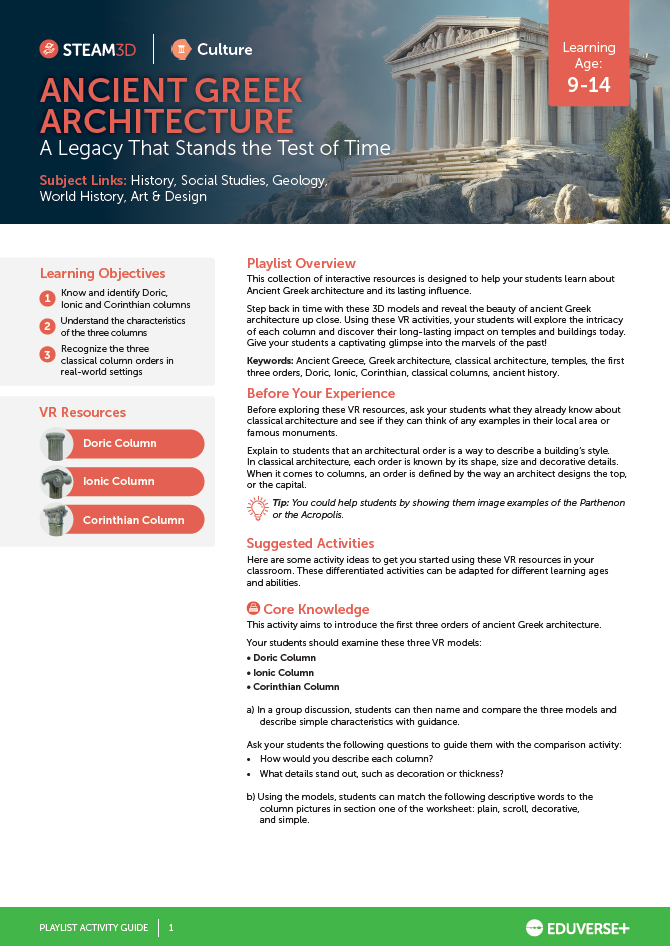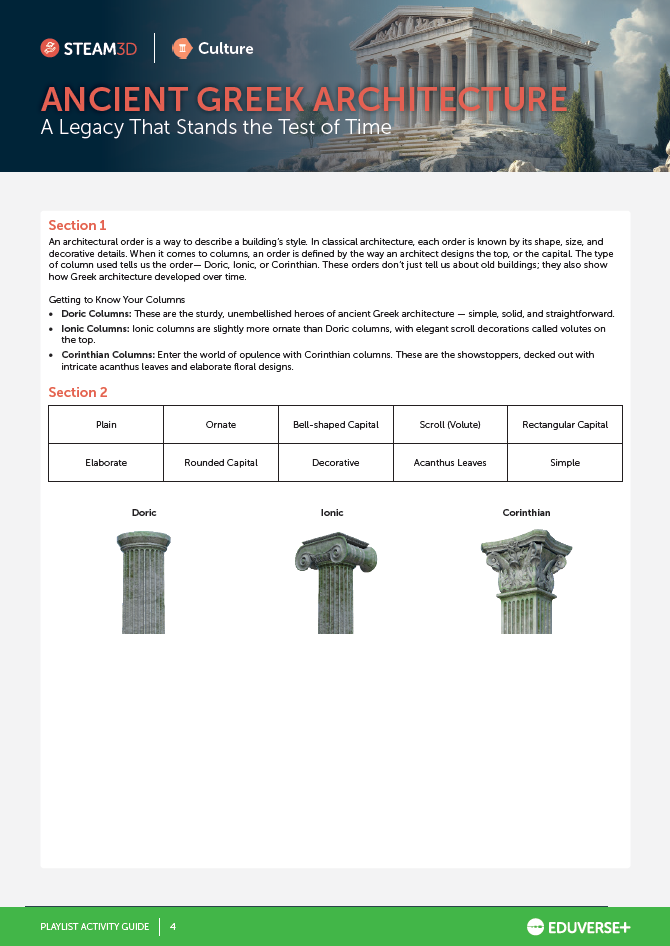 Loading...
Loading...
Initial language selection is based on your web browser preferences.
# ANCIENT GREEK ARCHITECTURE A Legacy That Stands the Test of Time **Learning Age:** 9 - 14 **Subject Links:** History, Social Studies, Geology, World History, Art & Design **Learning Objectives** *1. Know and identify Doric, Ionic and Corinthian columns*{.info} *2. Understand the characteristics of the three columns*{.info} *3. Recognize the three classical column orders in real-world settings*{.info} **Playlist Overview** This collection of interactive resources is designed to help your students learn about Ancient Greek architecture and its lasting influence. Step back in time with these 3D models and reveal the beauty of ancient Greek architecture up close. Using these VR activities, your students will explore the intricacy of each column and discover their long-lasting impact on temples and buildings today. Give your students a captivating glimpse into the marvels of the past! **Keywords:** Ancient Greece, Greek architecture, classical architecture, temples, the first three orders, Doric, Ionic, Corinthian, classical columns, ancient history. **VR Resources** - **Doric Column** - **Ionic Column** - **Corinthian Column** **Before Your Experience** Before exploring these VR resources, ask your students what they already know about classical architecture and see if they can think of any examples in their local area or famous monuments. Explain to students that an architectural order is a way to describe a building’s style. In classical architecture, each order is known by its shape, size and decorative details. When it comes to columns, an order is defined by the way an architect designs the top, or the capital. *Tip: You could help students by showing them image examples of the Parthenon or the Acropolis.* **Suggested Activities** Here are some activity ideas to get you started using these VR resources in your classroom. These differentiated activities can be adapted for different learning ages and abilities. # Core Knowledge{.objective .objective1} This activity aims to introduce the first three orders of ancient Greek architecture. Your students should examine these three VR models: - **Doric Column** - **Ionic Column** - **Corinthian Column** a) In a group discussion, students can then name and compare the three models and describe simple characteristics with guidance. Ask your students the following questions to guide them with the comparison activity: - How would you describe each column? - What details stand out, such as decoration or thickness? b) Using the models, students can match the following descriptive words to the column pictures in section one of the worksheet: plain, scroll, decorative, and simple. # Demonstrating Understanding{.objective .objective2} This activity guides students to develop a clearer understanding of the first three Greek architectural orders, emphasizing their defining characteristics. Examine the three VR models: - **Doric Column** - **Ionic Column** - **Corinthian Column** *Tip: Encourage students to read the model notes accessible via the menu bar to understand higher-level descriptive terms.* In a group discussion, ask students to compare the three models using descriptive terms like ornate, plain, decorative, volutes, capital, and flutes. Ask your students the following questions to guide them with the comparison activity: - What are the key differences between the column orders? - How do the columns differ in their intended purposes? - What fundamentals remain the same between the three column orders? Then, teachers should read out the following descriptions and ask their students to sketch they column they are describing on a piece of paper. *i) Doric: "I was the first and, therefore, the most important. With a simple circular capital and a plain column, you can find examples of me in Greece. Who am I?"* *ii) Ionic: "I may be the smallest, but I am decorated with volutes. With a strong base and elegant scrolls, you can find examples of me in Türkiye. Who am I?"* *iii) Corinthian: "I’m the most decorated of the three; my siblings are much more boring! With ornate acanthus leaves on my capital and a fluted column, you can find examples of me in Italy. Who am I?"* # Extended Learning{.objective .objective3} This activity builds on students' knowledge and understanding of column-order architectural features and challenges them to apply this learning to the world around them. Students will identify key features from real-world examples. Students should examine the 3D models and read the model notes accessible via the menu bar: - **Doric Column** - **Ionic Column** - **Corinthian Column** In groups, students should then discuss the uses and distinct features of each column type in Ancient Greece. Ask your students the following questions to guide them with the comparison activity: - Where might each column order be used in Ancient Greece? - What are the most distinct features of each column? - Where might they see these columns around the world? Using some plain paper, challenge your students to draw, label, and name each column, noting its shape, distinct differences, and purposes. To extend the learning further, your students should conduct independent research to find examples of all three column orders from famous monuments around the world. *Tip: You could look at the Thomas Jefferson Memorial, Supreme Court, Rome Colosseum, Temple of Artemis at Ephesus in Türkiye, or the British Museum.* **Cross-Curricular Links** **Geography & Art History** Students can use their knowledge to identify and map column orders closer to home. Either student or teacher should find examples of the three different column types in their local area, possibly showcased on significant buildings, art galleries, or places of cultural significance. **English Language & Dramatic Arts** Engage in ‘The Great Greek Column Debate’! Your students can represent and personify one of the three classical Greek column orders— Doric, Ionic, or Corinthian. They research their column’s historical significance in teams, craft persuasive arguments, and develop dramatic characters. During a debate, students use language and performance skills to argue why their column is still the most influential while the rest of the class acts as the audience or jury. # Activity Guide **Download the Activity Guide** [](https://avnfs.com/gMpL06fKzl-8HceZrUXWTFemNxRvkQMhUGxjpBvg38k?size=1572681&type=application%2Fpdf&name=Activity+Guide+-+Ancient+Greek+Architecture.pdf) # Student Worksheet **Download the Student Worksheet** [](https://avnfs.com/FfJT1hyAJSd5LU_2F3nketnjZ04VUFLtSjL4x2GFXxY?size=743677&type=application%2Fpdf&name=Student+Worksheet+-+Ancient+Greek+Architecture.pdf)